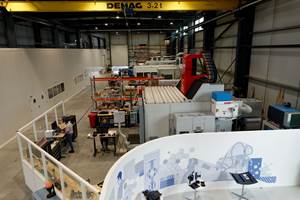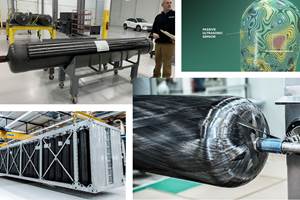Material Selection And Properties
The design process starts with determining the functional requirements of the component part. These requirements include: • Mechanical properties — tensile, compressive and flexural strength; elongation, impact resistance, hardness, density. • Electrical properties — dielectric strengt
The design process starts with determining the functional requirements of the component part. These requirements include:
• Mechanical properties — tensile, compressive and flexural strength; elongation, impact resistance, hardness, density.
• Electrical properties — dielectric strength, dielectric constant, arc resistance.
• Thermal properties — thermal conductivity, heat distortion, heat resistance, flammability, thermal coefficient of expansion.
• Chemical properties — resistance to acids, salt water and organic solvents; degree of water absorption; resistance to ozone, ultraviolet radiation and weathering.
With literally dozens of fibers and hundreds of resins to choose from, the composite material choices can be overwhelming. Fortunately, the design requirements usually dictate a narrow family of materials.
Fibers determine the overall mechanical properties of the structure, while the resin determines the overall physical properties of the structure. The resin matrix transfers the applied forces to the embedded high-strength fibers, helps the part resist the formation and propagation of cracks, and protects the fibers from damage due to environmental conditions such as corrosive chemicals. Stiffness or strength requirements determine whether glass, carbon or aramid should be used. Resistance to the expected environmental conditions (chemical, fluid and temperature) determines whether polyester, epoxy, vinyl ester, phenolic, thermoplastics or another resin class should be used.
Composite structures, or laminates, are defined by the orientation, thickness and material type of each ply. Multiple plies are used to build up a laminate to achieve the defined performance requirements. Plies with fibers parallel to the expected axial load are generally designated as 0° orientation; fibers perpendicular to the longitudinal axis are designated as 90°. Fiber plies can be oriented in any off-axis direction desired, to give strength in that direction. If all plies are of the same thickness and material, a simple notation can be used to define the stacking sequence. The ply angles are simply written in order, from top to bottom of the laminate. The majority of engineering laminates are balanced and symmetric, meaning that there are identical plies (same material, thickness and orientation) at equal distances above and below the laminate midplane.
The response of a composite structure to tensile loads is very dependent on the tensile stiffness and strength properties of the fibers. Under compressive load, the adhesive and stiffness properties of the resin system are crucial, because the resin must maintain the fibers as straight columns to prevent buckling and transfer shear stress between the fibers.
Ply stiffness is a function of fiber angle. Adjacent plies with different fiber orientation have different stiffnesses. This mismatch means that stress is discontinuous between the plies. To maintain equilibrium, an interlaminar shear stress forms between the plies, in the thin layer of resin that holds the plies together. Under shear loads, the shear strength of the resin must be high enough to support these stresses, and must have good adhesion to the fibers.
The bearing strength of composites is usually lower than that of metals, and is a function of laminate layup design and torque. The failure mode is generally a combination of localized crushing, microbuckling and shearout.
Composites have some properties that may be non-intuitive to engineers accustomed to working only with metals. The two most important properties are shear coupling and bending-coupling. In shear coupling, a pure tensile or compressive load creates shear stresses in off-axis plies. In bending-coupling, a nonsymmetric laminate acts like a bimetallic strip. Application of a pure in-plane load, or even a temperature change, will cause the laminate to warp or twist. Bending-coupling is easily avoided by designing only with symmetric laminates.
Related Content
Recycling hydrogen tanks to produce automotive structural components
Voith Composites and partners develop recycling solutions for hydrogen storage tanks and manufacturing methods to produce automotive parts from the recycled materials.
Read MorePlant tour: Daher Shap’in TechCenter and composites production plant, Saint-Aignan-de-Grandlieu, France
Co-located R&D and production advance OOA thermosets, thermoplastics, welding, recycling and digital technologies for faster processing and certification of lighter, more sustainable composites.
Read MoreNatural fiber composites: Growing to fit sustainability needs
Led by global and industry-wide sustainability goals, commercial interest in flax and hemp fiber-reinforced composites grows into higher-performance, higher-volume applications.
Read MoreHexagon Purus Westminster: Experience, growth, new developments in hydrogen storage
Hexagon Purus scales production of Type 4 composite tanks, discusses growth, recyclability, sensors and carbon fiber supply and sustainability.
Read MoreRead Next
“Structured air” TPS safeguards composite structures
Powered by an 85% air/15% pure polyimide aerogel, Blueshift’s novel material system protects structures during transient thermal events from -200°C to beyond 2400°C for rockets, battery boxes and more.
Read More





















